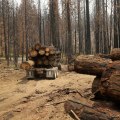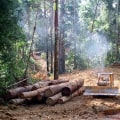When it comes to cutting down trees in the UK, there are certain rules and regulations that must be followed. In general, it is illegal to cut down trees without permission from the local council, unless the tree is less than 75 mm in diameter or is being cut down to enhance the growth of another tree. It is also a crime to cut down trees that are protected by a Tree Conservation Order without permission. In some cases, a logging license may be required, and there are exceptions to this rule.
The Forestry Commission has been in place for 50 years and helps maintain compliance with environmental standards that ensure sustainable forest management and timber production (UKFS). Our guide “Logging: Getting Permit” explains when a logging license is needed and how to apply. In some cases, exceptions may apply or other permits may be applied to allow logging to continue. When making a planning request, you will need to indicate if there are any trees on the site or nearby that may be affected by the proposed works.
Before anyone can cut down trees, they may need to obtain a logging license from the Forestry Commission. Ancient forests and old or veteran trees are within areas with legal conservation designations, so permission must be obtained from the designated statutory body unless it is an emergency. It is important to note that trees belong to the land from which they originally grew, even if branches or roots have begun to invade the property of a neighbor. In some cases, it may be necessary to cut down a tree if it poses a security risk due to its location or condition, or is shown to damage property.
Trees and forests provide us with valuable timber resources that are needed for a wide range of daily products, as well as biomass for fuel and energy production. If you need to cut down a tree, it is important to hire an experienced arborist who will ensure that the problem is sufficiently resolved while keeping as much of the tree as possible. They should also have liability insurance in case something goes wrong during the process. In addition, many trees are protected by tree conservation orders, which are issued by local planning authorities to protect specific trees.
It is important to read the local laws in the tree ordinance or use an Internet search to verify what is required for your city or state. Finally, it is important to remember that any cut tree branches belong to the person whose land the tree grew first, so it's a good practice to ask your neighbor if you want them back or if you don't mind getting rid of them during the process.



